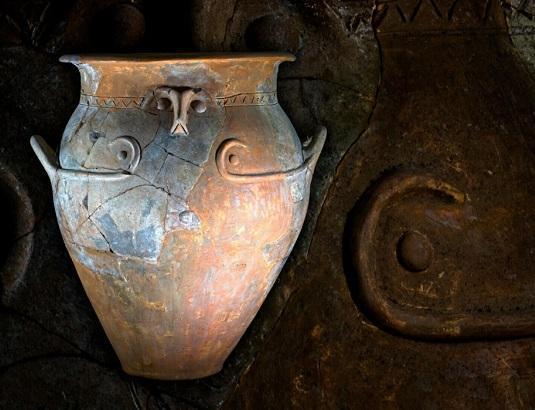Two artifacts put on display at İzmir Archeology Museum
İZMİR

The İzmir Archeology Museum has put on display a 5,000-year-old historical limestone stele, depicting the silhouette of a praying person, and a 4,000-year-old terracotta pottery with a human face on it, belonging to the Early Bronze Age.
“The stele shows a ritual for defense against the enemy. This artifact may have been used at the gate of the fortification wall to deter threats from outside,” said the İzmir Archeology Museum Director Hünkar Keser.
Museum official Elvan Tural stated that they believe the pottery was used as a ceremonial vessel for storing wheat germ or sacred liquids.
As part of the “12 Months and 12 Exhibitions” project, carried out by the İzmir Archeology Museum, the artifacts that have been registered in the museum inventory and have not been exhibited before, are put on display.
In the exhibition held this month, two more rare artifacts from the Early Bronze Age are being presented to the museum visitors.
The 5,000-year-old stele, which was unearthed during the construction of the State Hydrualic Works (DSI) canal in the 1990s, which passes through the foot of the Höyücek Mound in the Menemen district, was hung on the fortification gate, which is believed to protect the inhabitants of the city against possible enemies.
The 4,000-year-old terracotta pottery, which was found in 2012 at Liman Tepe Mound in Urla, is also a valuable piece of art.
“The Höyücek stele was unearthed in two parts and in two different times in the 1990s during an infrastructure work. We can date it to the Early Bronze Age. It gives information about beliefs, cultures and rituals dating 5,000 years ago. We think that the person on the stele is praying. These types of figures represent a belief and they are for protection. It depicts a defensive ritual against the enemy. This artifact may have been used at the gate of the fortification wall as a deterrent against external dangers,” said Keser.
Tural, on the other hand, pointed out that the terracotta pottery is an artifact dating back to about 4,000 years ago and said, “It reflects the characteristics of the period. There is a depiction of a human face on the pot. We think that a sacred liquid or wheat was stored in it. These are special vessels. They were used during a ritual or ceremony. We don’t come across such containers very often.”
















